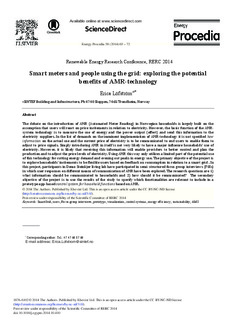| dc.contributor.author | Löfström, Erica | |
| dc.date.accessioned | 2016-02-03T12:17:14Z | |
| dc.date.accessioned | 2016-02-10T08:02:00Z | |
| dc.date.available | 2016-02-03T12:17:14Z | |
| dc.date.available | 2016-02-10T08:02:00Z | |
| dc.date.issued | 2014 | |
| dc.identifier.issn | 1876-6102 | |
| dc.identifier.uri | http://hdl.handle.net/11250/2378668 | |
| dc.description.abstract | The debate on the introduction of AMR (Automated Meter Reading) in Norwegian households is largely built on the assumption that users will react on price incitements in relation to electricity. However, the basic function of the AMR-system technology is to measure the use of energy and the power output (effect) and send this information to the electricity suppliers. In the list of demands on the imminent implementation of AMR-technology it is not specified how information on the actual use and the current price of electricity is to be communicated to end users to enable them to adjust to price signals. Simply introducing AMR in itself is not very likely to have a major influence households’ use of electricity. However, it is likely that receiving this information will enable providers to better control and plan the production and to adjust the price levels of electricity. Using AMR this way only utilizes a limited part of the potential use of this technology for cutting energy demand and evening out peaks in energy use. The primary objective of the project is to explore households’ incitements to be flexible users based on feedback on consumption in relation to a smart grid. In this project, participants in Demo Steinkjer living lab have participated in semi-structured focus group interviews (FGIs) in which user responses on different means of communication of AMR have been explored. The research questions are 1) what information should be communicated to households and 2) how should it be communicated? The secondary objective of the project is to use the results of the study to specify which functionalities are relevant to include in a prototype app-based control system for household functions based on AMR. | |
| dc.language.iso | eng | nb_NO |
| dc.publisher | Elsevier | nb_NO |
| dc.rights | CC BY NC ND 3.0 | * |
| dc.rights.uri | http://creativecommons.org/licenses/by-nc-nd/3.0/ | |
| dc.subject | SmartGrid | |
| dc.subject | Users | |
| dc.subject | Focus group interviews | |
| dc.subject | Prototype | |
| dc.subject | Visualization | |
| dc.subject | Control systems | |
| dc.subject | Energy efficiency | |
| dc.subject | Sustainability | |
| dc.subject | AMS | |
| dc.title | Smart meters and people using the grid: exploring the potential benefits of AMR-technology | |
| dc.type | Journal article | |
| dc.type | Peer reviewed | |
| dc.date.updated | 2016-02-03T12:17:14Z | |
| dc.description.version | publishedVersion | |
| dc.rights.holder | © 2014 The authors | |
| dc.subject.nsi | VDP::Technology: 500 | |
| dc.source.pagenumber | 65-72 | |
| dc.source.volume | 58 | |
| dc.source.journal | Energy Procedia | |
| dc.identifier.doi | 10.1016/j.egypro.2014.10.410 | |
| dc.identifier.cristin | 1158622 | |

